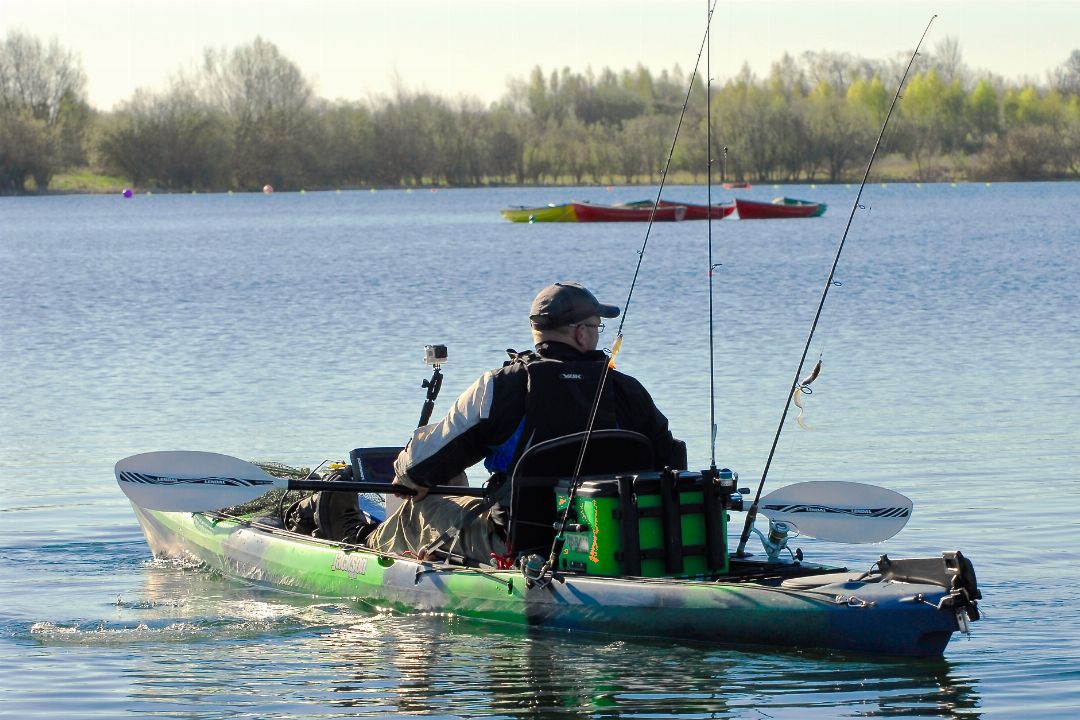Beginner’s Guide to Kayak Fishing: Tips and Tricks

Welcome to the thrilling world of kayak fishing! Whether you’re a seasoned angler looking for a new challenge or a complete beginner eager to dive into the world of fishing, this comprehensive guide is tailored just for you. Kayak fishing is not just a recreational activity; it’s an immersive experience that brings you closer to nature and enhances your fishing skills. In this guide, we’ll walk you through everything you need to know as a beginner, from choosing the right kayak to mastering essential fishing techniques. Let’s embark on this exciting journey together!
Benefits of Kayak Fishing
Enhanced Connection with Nature
Kayak fishing isn’t just about catching fish; it’s about immersing yourself in nature. The low profile of a kayak allows you to navigate waters quietly, observing wildlife in their natural habitat. This closeness to nature enhances the overall fishing experience, creating memories that go beyond the catch.
Physical and Mental Health Benefits
Beyond the thrill of the catch, kayak fishing provides a fantastic workout. Paddling engages core muscles and improves cardiovascular health. The serenity of being on the water also contributes to mental well-being, reducing stress and promoting relaxation.
Cost-Effectiveness
Compared to motorized boats, kayaks are a cost-effective option for fishing enthusiasts. With minimal maintenance and no fuel expenses, kayak fishing allows you to enjoy the sport without breaking the bank. It’s an accessible and budget-friendly way to indulge in your passion for fishing.
Getting Started with Kayak Fishing
Choosing the Right Kayak
Selecting the right kayak is crucial for a successful fishing experience. Consider the type, size, and stability of the kayak. Sit-on-top kayaks are popular for fishing due to their stability and ease of access. Brands like Ocean Kayak and Hobie offer excellent options for beginners.
Essential Gear and Equipment
Before setting out on your kayak fishing adventure, ensure you have the right gear. A comprehensive fishing gear checklist includes fishing rods, reels, tackle boxes, and bait. Additionally, prioritize safety equipment like life jackets and a basic first aid kit to ensure a secure and enjoyable fishing experience.
Proper Attire for Kayak Fishing
Dress for success! Choose clothing suitable for the weather conditions you’ll encounter. Quick-drying materials are ideal, and don’t forget to apply sunscreen and wear a hat for sun protection. Staying comfortable and protected ensures you can focus on the fishing experience without distractions.
Kayak Fishing Techniques for Beginners
Paddling Basics
Mastering basic paddling techniques is fundamental for any kayak angler. Start with the proper grip on your paddle – hands shoulder-width apart, and blades oriented correctly. Efficient strokes and a proper paddling rhythm will help you maneuver your kayak effectively.
Remember, the key to successful paddling is a combination of proper technique and efficient energy use. Don’t be discouraged if it takes a bit of practice to get the hang of it. Find a calm, open area to practice your strokes and turning maneuvers before heading to your favorite fishing spot.
Casting Techniques
Once you’ve mastered paddling, it’s time to focus on casting techniques. For beginners, overhead casting is a reliable method. Hold the rod comfortably, ensuring a smooth and controlled motion during casting. Practice in an open area to build confidence and accuracy.
Invest time in learning different casting styles, such as flipping and pitching, as they can be advantageous in specific fishing situations. Remember, practice makes perfect – honing your casting skills pays off when you’re on the water targeting your favorite fish species.
Setting Up Your Fishing Gear
Before casting your line, ensure your kayak is properly rigged for fishing. Secure your fishing rods in designated rod holders, keeping them within easy reach. Use a tackle box to organize and store lures, bait, and other essentials.
Consider installing accessories like fish finders or GPS units to enhance your fishing experience. Modern kayaks often come with dedicated mounts for these gadgets. Being organized and having quick access to your gear ensures a seamless and enjoyable fishing trip.
Choosing the Right Fishing Spots
Selecting the right fishing spots is a game-changer in kayak fishing. Here’s how to maximize your chances of a successful catch:
Identifying Fish Habitats: Different fish species prefer specific habitats. Learn about the habits of your target fish whether they’re in shallow waters, near structures like rocks or vegetation, or in deeper areas. Understanding fish behavior increases your chances of a rewarding catch.
Research Local Regulations: Before heading out, familiarize yourself with local fishing regulations and restrictions. Some areas may have specific rules on catch limits, protected species, or even restricted access. Adhering to these regulations ensures both a sustainable fishing experience and avoids legal complications.
Safety Tips for Kayak Fishing
Weather Considerations
Weather plays a significant role in kayak fishing safety. Stay informed about the forecast, paying attention to wind conditions and potential storms. High winds can make paddling challenging, and sudden storms pose safety risks. Use reliable weather apps or a VHF radio to stay updated while on the water.
Basic Navigation Skills
Develop basic navigation skills to confidently explore fishing spots and return safely. Familiarize yourself with local maps, landmarks, and navigation aids. GPS devices are valuable tools for tracking your location and marking productive fishing spots. A solid understanding of your surroundings enhances your overall safety and enjoyment.
Emergency Preparedness
Create an emergency plan before embarking on any kayak fishing trip. Inform someone about your itinerary and expected return time. Carry essential safety items, including a first aid kit, whistle, and a communication device such as a waterproof VHF radio or a reliable mobile phone in a waterproof case.
Fish Handling and Conservation
Responsible fish handling is vital for the health of fish populations and the sustainability of your favorite fishing spots. Follow these guidelines to ensure proper catch-and-release practices:
Proper Catch-and-Release Techniques: When catching fish, handle them with care. Wet your hands before touching the fish to protect their slime coat. Use needle-nose pliers or a de-hooking tool to remove the hook gently. Minimize the time the fish spends out of the water and support its body properly during release.
Understanding Catch Limits: Stay informed about catch limits and size regulations for the species you’re targeting. Knowing the rules helps maintain a balanced fish population and ensures future generations can enjoy the sport.
As you embrace responsible angling, you contribute to the conservation of aquatic ecosystems. Now, let’s delve into troubleshooting common issues that beginners might encounter during kayak fishing trips.
Troubleshooting Common Issues
Dealing with Tangled Lines
Tangled lines can be frustrating, but knowing how to handle them efficiently is essential. Here are some tips:
Preventive Measures: Use tackle organizers to keep your gear organized and minimize the chances of tangles. Be mindful of your casting technique, and avoid unnecessary movements that may lead to line entanglement.
Untangling Techniques: When a tangle occurs, stay calm. Use patience and a systematic approach to untangle the lines. In some cases, cutting and retying might be the quickest solution.
Capsizing and Recovery Techniques
While capsizing is rare, knowing how to recover is crucial for your safety. Follow these steps:
Stay Calm: If your kayak capsizes, stay calm. Remember that kayaks are designed to float, and you have a life jacket for buoyancy.
Recovery Procedures: Practice capsizing and re-entry in a controlled environment to build confidence. Learn self-rescue techniques, such as the paddle float rescue or the re-entry and roll maneuver.
Joining Kayak Fishing Communities
Embarking on your kayak fishing journey is not a solo adventure – it’s a community-driven experience. Engaging with kayak fishing communities offers a multitude of benefits:
Sharing Knowledge: Connect with fellow kayak anglers to exchange tips, tricks, and firsthand experiences. Online forums, social media groups, and local clubs provide valuable insights that can enhance your skills and broaden your understanding of kayak fishing.
Learning from Experienced Anglers: Seasoned kayak anglers often share their expertise willingly. Joining a community allows you to learn from those who have faced similar challenges and conquered them. This shared knowledge accelerates your learning curve, making you a more proficient angler.
Organizing Group Outings: Kayak fishing communities often organize group outings. Participating in these events not only adds a social aspect to your hobby but also provides an opportunity to explore new fishing spots and learn from the collective experience of the group.
FAQs About Kayak Fishing for Beginners
What type of kayak is best for beginners?
The best kayak for beginners depends on various factors, including your preferred fishing environment, stability requirements, and budget. Generally, sit-on-top kayaks are popular for their stability and ease of use, making them suitable for beginners.
How do I choose the right fishing spot?
Choosing the right fishing spot involves understanding the habits of the fish species you’re targeting. Research local waters, identify potential habitats, and adhere to fishing regulations. Local fishing communities and online resources can provide valuable insights into productive fishing spots.
What safety precautions should I take?
Safety is paramount in kayak fishing. Always wear a life jacket, monitor weather conditions, and carry essential safety gear. Inform someone about your plans, develop basic navigation skills, and have an emergency plan in place.
Is kayak fishing suitable for all ages?
Yes, kayak fishing is suitable for individuals of various ages. However, it’s essential to consider physical fitness, comfort, and safety measures. Choose a kayak that suits your needs, and always prioritize safety on the water.
Conclusion
Congratulations! You’ve now gained a solid foundation for your journey into kayak fishing. From choosing the right equipment and mastering essential techniques to ensuring safety and conservation, this beginner’s guide has covered it all. Remember to stay curious, keep learning, and most importantly, enjoy the beauty of nature while reeling in your next big catch.
Embark on your kayak fishing adventures with confidence, armed with the knowledge and skills needed to make each trip a success. Whether you’re gliding through serene lakes or navigating coastal waters, the world of kayak fishing is yours to explore.


